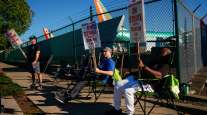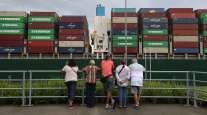Soon-to-Be New York Fed Chief John Williams Sees Little Risk in Rate Hikes

John Williams, who will take the helm of the Federal Reserve Bank of New York in June, played down risks the yield curve would become inverted as the U.S. central bank gradually raises interest rates.
Speaking in Madrid on April 17, the current president of the Fed’s San Francisco branch said a truly inverted yield curve “is a powerful signal of recessions” that historically has occurred “when the Fed is in a tightening cycle, and markets lose confidence in the economic outlook.” That is not the case now, he said.
“The flattening of the yield curve that we’ve seen is so far a normal part of the process, as the Fed is raising interest rates, long rates have gone up somewhat — but it’s totally normal that the yield curve gets flatter,” Williams said.
RELATED: IMF spots trouble for global economy after 2020
The spread between two- and 10-year U.S. Treasury yields is the narrowest in more than a decade as investors price in a slightly steeper pace of Fed tightening. Williams, who sees three or four rate hikes in 2018 — placing him solidly with the majority of policy makers — said, “I don’t see the signs yet of an inverted yield curve.”
Williams will become a key member of Fed Chairman Jerome Powell’s leadership team when he takes charge in New York on June 18. That team was augmented April 16 by President Donald Trump’s announcement that he plans to nominate Pacific Investment Management Co.’s Richard Clarida as vice chairman. Williams said he was looking forward to working with the longtime Columbia University professor who, like him, is a respected monetary economist.
RELATED: US recession may come just in time for Trump’s re-election bid
Interpreting market signals will be a key job for Williams in New York, where he’ll be the Fed’s key eyes and ears on Wall Street. A potential source of risk has emerged in recent weeks with the widening in the spread between Libor — the London interbank offered rate — and the overnight indexed swap rate, which has risen to levels unseen since the financial crisis. Williams played this down.
Structural Factors
“At least so far, the main culprits, whenever you look at these kind of developments in money markets, are really kind of structural factors,” he said, noting there had been an increase in Treasury-bill issuance among other potential influences on rates.
“It’s natural but misleading to go back to the crisis,” he said, because back then the widening in the Libor-OIS spread was a strong signal of banking crisis. “It’s not about the health of the banks; it’s really more aboutt, I think, some technical factors.”
RELATED: Treasury Secretary Steven Mnuchin says there’s ‘level of risk’ of US-China trade war
Williams, speaking at a National Association for Business Economics-Bank of Spain International Symposium, was upbeat on the outlook for the U.S. economy. He said inflation was closing in on the Fed’s 2% target, and he saw the jobless rate falling to 3.5% next year while U.S. growth averages around 2.5% this year and next.
“My own forecast would be that interest rates are going to move up gradually, smoothly. It’s going to be like a 747 landing, and people don’t even realize that they can turn their phones on,” Williams said.
One cloud on the horizon was the potential for an escalation in the trade spat between the Trump administration and nations including China.
Developments — so far — have not affected his economic outlook.
“What worries me in this trade discussion is that uncertainty, even without action, can have a detrimental effect,” he said, and this could get worse if relations deteriorate.
A full-on trade war would be “very negative for the economic outlook,” he said.




